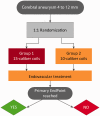Endovascular treatment of aneurysms and platinum coil caliber: Study protocol of a randomized, controlled trial
- PMID: 27530135
- PMCID: PMC5564365
- DOI: 10.1177/1591019916663471
Endovascular treatment of aneurysms and platinum coil caliber: Study protocol of a randomized, controlled trial
Abstract
Background: Endovascular coil embolization of cerebral aneurysms is an effective treatment for the prevention of aneurysm rebleeding after subarachnoid hemorrhage. It is also often used in unruptured aneurysms, but it is associated with aneurysm remnants and recurrences in up to 20%-33% of patients. We hypothesized that better aneurysm occlusion rates can be achieved with coils of larger caliber.
Methods: The Does Embolization with Larger coils lead to better Treatment of Aneurysms (DELTA) trial is an investigator-initiated, multicenter, prospective, randomized, controlled clinical trial. To test the hypothesis that 15-caliber coiling systems are superior to 10-caliber coils, 564 patients with aneurysms measuring 4-12 mm will be randomized 1:1 to embolization with either 10-caliber coils exclusively (control group) or the highest safely achievable proportion of 15-caliber coils (intervention group). The primary efficacy endpoint of the trial is the occurrence of a major recurrence or a residual aneurysm at one year. A pilot phase of 165 patients will be conducted to verify feasibility of the coiling strategy, compliance to treatment allocation, safety of a 15-caliber platinum coil embolization strategy, recruitment rates, and the capacity to improve packing density.
Discussion: The DELTA trial will test the hypothesis that the use of coils of larger caliber can improve angiographic results of endovascular coiling.
Keywords: Cerebral aneurysm; controlled trial; endovascular coil embolization; packing density; randomized.
© The Author(s) 2016.
Similar articles
-
Does Increasing Packing Density Using Larger Caliber Coils Improve Angiographic Results of Embolization of Intracranial Aneurysms at 1 Year: A Randomized Trial.AJNR Am J Neuroradiol. 2020 Jan;41(1):29-34. doi: 10.3174/ajnr.A6362. Epub 2020 Jan 2. AJNR Am J Neuroradiol. 2020. PMID: 31896568 Free PMC article. Clinical Trial.
-
Embolization with larger-caliber coils can increase packing density: Evidence from the pilot phase of a randomized trial.Interv Neuroradiol. 2017 Feb;23(1):14-17. doi: 10.1177/1591019916668841. Epub 2016 Oct 22. Interv Neuroradiol. 2017. PMID: 27760884 Free PMC article. Clinical Trial.
-
GREAT-a randomized controlled trial comparing HydroSoft/HydroFrame and bare platinum coils for endovascular aneurysm treatment: procedural safety and core-lab-assessedangiographic results.Neuroradiology. 2016 Aug;58(8):777-86. doi: 10.1007/s00234-016-1693-y. Epub 2016 Apr 30. Neuroradiology. 2016. PMID: 27137926 Clinical Trial.
-
[Forum: Clips and coils in aneurysm treatment].Wien Med Wochenschr. 1997;147(7-8):172-7. Wien Med Wochenschr. 1997. PMID: 9297366 Review. German.
-
Advances in endovascular aneurysm management: coiling and adjunctive devices.Stroke Vasc Neurol. 2020 Mar 15;5(1):14-21. doi: 10.1136/svn-2019-000303. eCollection 2020. Stroke Vasc Neurol. 2020. PMID: 32411403 Free PMC article. Review.
Cited by
-
Angiographic and clinical results of anterior communicating artery aneurysm endovascular treatment.Wideochir Inne Tech Maloinwazyjne. 2019 Sep;14(3):451-460. doi: 10.5114/wiitm.2019.81406. Epub 2019 Jan 21. Wideochir Inne Tech Maloinwazyjne. 2019. PMID: 31534577 Free PMC article.
-
Optimizing neurointerventional procedures: an algorithm for embolization coil detection and automated collimation to enable dose reduction.J Med Imaging (Bellingham). 2024 Jul;11(4):044003. doi: 10.1117/1.JMI.11.4.044003. Epub 2024 Jul 17. J Med Imaging (Bellingham). 2024. PMID: 39035051 Free PMC article.
References
-
- Molyneux AJ, Kerr RS, Yu LM, et al. International subarachnoid aneurysm trial (ISAT) of neurosurgical clipping versus endovascular coiling in 2143 patients with ruptured intracranial aneurysms: A randomised comparison of effects on survival, dependency, seizures, rebleeding, subgroups, and aneurysm occlusion. Lancet 2005; 366: 809–817. - PubMed
-
- Naggara ON, Lecler A, Oppenheim C, et al. Endovascular treatment of intracranial unruptured aneurysms: A systematic review of the literature on safety with emphasis on subgroup analyses. Radiology 2012; 263: 828–835. - PubMed
-
- Lecler A, Raymond J, Rodriguez-Régent C, et al. Intracranial aneurysms: Recurrences more than 10 years after endovascular treatment—A prospective cohort study, systematic review, and meta-analysis. Radiology 2015; 277: 173–180. - PubMed
-
- Ferns SP, Sprengers ME, van Rooij WJ, et al. Coiling of intracranial aneurysms: A systematic review on initial occlusion and reopening and retreatment rates. Stroke 2009; 40: e523–e529. - PubMed
Publication types
MeSH terms
Substances
LinkOut - more resources
Full Text Sources
Other Literature Sources
Medical


